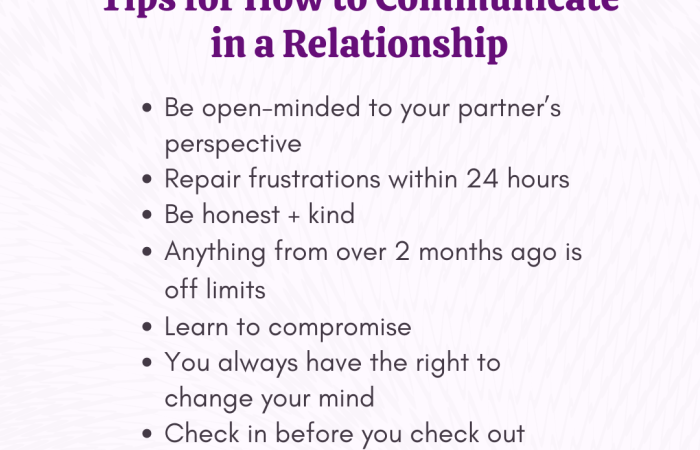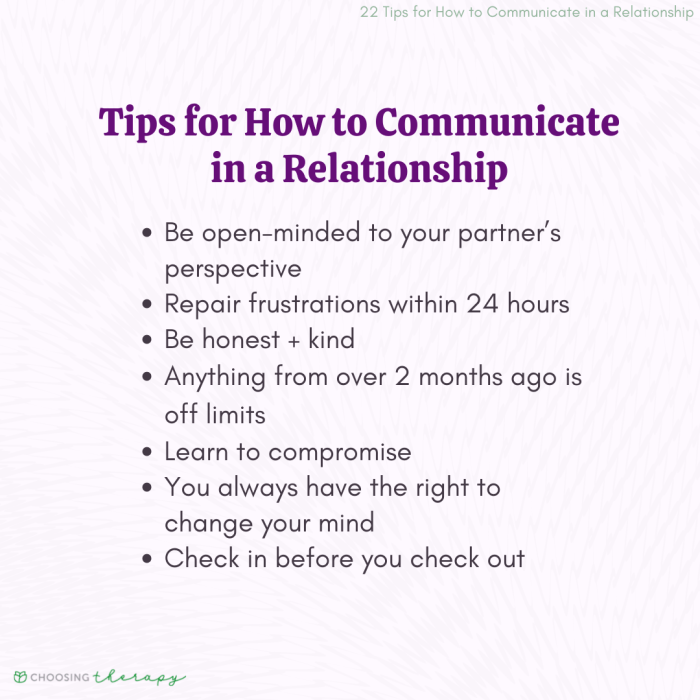Communication Tips for Couples: Strengthen Your Bond

Communication Tips for Couples sets the stage for a journey of understanding and growth within your relationship. Effective communication is the cornerstone of a healthy and fulfilling partnership, and this guide offers practical strategies to enhance your connection and navigate life’s challenges together.
From active listening to expressing needs and managing conflicts, we explore a range of techniques that can help you build a stronger and more harmonious bond.
This comprehensive guide delves into various aspects of communication, highlighting the importance of understanding your partner’s communication style, fostering a safe and supportive environment, and navigating digital communication in a way that strengthens your connection. By embracing these tips, you can create a communication dynamic that fosters trust, intimacy, and lasting happiness.
Active Listening and Understanding

Active listening is a fundamental skill in any relationship, but it is especially crucial for couples. When you actively listen to your partner, you show them that you value their thoughts and feelings, which strengthens the bond between you. It fosters empathy, understanding, and a sense of being heard, leading to more effective communication and conflict resolution.
Improving Active Listening Skills
Effective active listening requires conscious effort and practice. Here are some tips to improve your active listening skills:
- Maintain Eye Contact: Looking at your partner while they speak conveys your attentiveness and interest. It helps you stay focused and understand their nonverbal cues.
- Ask Clarifying Questions: To ensure you understand their perspective, ask open-ended questions to encourage elaboration and seek clarification on specific points.
- Avoid Interruptions: Allow your partner to express themselves fully without interrupting. Resist the urge to jump in with your thoughts or opinions until they have finished speaking.
- Summarize and Reflect: Paraphrase what you have heard to confirm your understanding and show that you are actively listening. Reflect on their feelings and acknowledge their emotions.
- Use Nonverbal Cues: Nodding your head, maintaining an open posture, and using appropriate facial expressions demonstrate your engagement and understanding.
Examples of Active Listening Techniques
Active listening techniques can be applied in various daily conversations. Here are some examples:
“I hear you saying that you feel stressed about work. Can you tell me more about what’s causing you this stress?”
“It sounds like you’re feeling frustrated about the way I handled that situation. I understand why you’re upset, and I want to hear more about your perspective.”
“You’re right, I didn’t communicate my needs clearly. I’ll try to be more specific in the future.”
These examples demonstrate how active listening can be used to build understanding, validate feelings, and promote open communication in a relationship.
Effective Communication Styles
Understanding and adapting to different communication styles is crucial for healthy relationships. Communication styles are the unique ways in which individuals express themselves and interpret messages. These styles can significantly impact how partners perceive and respond to each other’s communication, leading to misunderstandings or, conversely, fostering deeper connections.
Identifying Communication Styles
Recognizing the communication styles of both partners is the first step toward effective communication. This involves observing how each partner expresses themselves, listens to others, and responds to different situations. Some common communication styles include:
- Assertive: Assertive communicators clearly express their thoughts and feelings while respecting the views of others. They are direct, honest, and confident in their communication.
- Passive: Passive communicators often avoid expressing their needs and opinions, often leading to frustration and resentment. They may struggle to assert themselves and may be overly accommodating.
- Aggressive: Aggressive communicators prioritize their own needs and may disregard the feelings of others. Their communication is often characterized by blaming, interrupting, and using harsh language.
- Passive-Aggressive: Passive-aggressive communicators express their frustration indirectly through sarcasm, subtle insults, or withholding information. They may avoid confrontation but convey their dissatisfaction through veiled messages.
Strengths and Weaknesses of Different Communication Styles
Each communication style has its strengths and weaknesses. Understanding these can help partners appreciate each other’s perspectives and navigate potential challenges.
- Assertive: Assertive communication fosters open and honest dialogue, promoting mutual respect and understanding. However, it can be perceived as confrontational or aggressive if not used appropriately.
- Passive: While passive communication can contribute to a peaceful environment, it can lead to suppressed emotions and resentment. Partners may feel unheard and their needs may not be met.
- Aggressive: Aggressive communication can be effective in demanding situations, but it can damage relationships and create a hostile atmosphere. It can lead to conflict and undermine trust.
- Passive-Aggressive: Passive-aggressive communication can be confusing and frustrating for both partners. It can create misunderstandings and erode trust, making it difficult to address issues constructively.
Navigating Differences in Communication Styles
Differences in communication styles are common and can be a source of conflict. However, with awareness and effort, couples can learn to navigate these differences effectively.
- Open Communication: Encourage open and honest discussions about each other’s communication styles. This includes acknowledging your style and its potential impact on your partner.
- Active Listening: Practice active listening to understand your partner’s perspective, even if you don’t agree with it. This involves paying attention, asking clarifying questions, and summarizing what you hear.
- Empathy and Validation: Try to understand your partner’s feelings and acknowledge their point of view, even if you don’t share it. This can help create a sense of understanding and respect.
- Compromise and Flexibility: Be willing to compromise and adapt your communication style to meet your partner’s needs. This may involve adjusting your tone, pace, or choice of words.
- Seeking Professional Help: If you are struggling to navigate differences in communication styles, consider seeking professional help from a therapist or counselor. They can provide guidance and support in developing healthier communication patterns.
Expressing Needs and Feelings
Open and honest communication is crucial for a healthy relationship. A key aspect of this is effectively expressing your needs and feelings. When you can clearly articulate what you need and how you feel, you allow your partner to understand you better and respond appropriately.
Importance of Clear and Direct Communication
Expressing your needs and feelings directly helps avoid misunderstandings and promotes a sense of understanding and connection. When you are open and honest, you create a safe space for your partner to reciprocate and share their thoughts and feelings.
Tips for Expressing Needs and Feelings Constructively
- Use “I” Statements: Instead of blaming your partner, focus on how their actions make you feel. For example, instead of saying “You never listen to me,” try “I feel unheard when I share my thoughts with you.”
- Be Specific: Avoid vague statements and be clear about what you need. For example, instead of “I need more attention,” say “I would appreciate it if we could spend more quality time together, like going for a walk on the weekends.”
- Choose the Right Time and Place: Avoid bringing up sensitive topics when you are both stressed or tired. Find a calm and private moment to have a conversation.
- Be Respectful: Even when you are upset, maintain a respectful tone. Avoid insults or accusations.
- Listen to Your Partner’s Response: After expressing your needs and feelings, be open to hearing your partner’s perspective. Listen actively and try to understand their point of view.
Handling Disagreements and Conflicts Constructively
- Focus on the Issue, Not the Person: When disagreements arise, focus on the specific issue at hand and avoid personal attacks.
- Take Breaks When Needed: If emotions are running high, take a break from the conversation to calm down and collect your thoughts.
- Find Common Ground: Even in disagreements, there is often common ground. Look for areas where you can agree and build from there.
- Compromise: Be willing to compromise and find solutions that work for both of you.
- Seek Professional Help: If you find it difficult to resolve conflicts constructively, consider seeking professional help from a couples therapist.
Building Trust and Intimacy

Trust and intimacy are the cornerstones of any strong and lasting relationship. They are built upon a foundation of open and honest communication, where both partners feel safe and supported to express themselves authentically.
Fostering a Safe and Supportive Communication Environment, Communication tips for couples
Creating a safe space for communication is crucial for building trust and intimacy. This means establishing a non-judgmental environment where both partners feel comfortable sharing their thoughts and feelings without fear of criticism or retaliation.
- Active Listening: Practice active listening skills, such as making eye contact, nodding, and asking clarifying questions. This demonstrates that you are genuinely interested in what your partner has to say and value their perspective.
- Empathy and Validation: Try to understand your partner’s point of view, even if you don’t agree with it. Validate their feelings and acknowledge their experiences, even if they are different from your own.
- Non-Verbal Communication: Pay attention to non-verbal cues, such as body language and tone of voice. These can often convey more than words alone.
- Avoid Interrupting: Allow your partner to finish their thoughts without interrupting. This shows respect and allows for a more complete understanding of their perspective.
The Role of Vulnerability and Emotional Sharing
Vulnerability is essential for building intimacy. It involves being open and honest about your thoughts, feelings, and experiences, even the ones that may make you feel uncomfortable or exposed.
- Share Your Fears and Insecurities: Sharing your vulnerabilities can help your partner understand you better and build a stronger connection. It also shows that you trust them enough to be open and honest.
- Express Your Needs and Desires: Being open about your needs and desires allows your partner to understand what makes you happy and how to support you. It also helps prevent misunderstandings and resentment.
- Seek Emotional Support: Don’t be afraid to ask for emotional support from your partner when you need it. This shows that you trust them and value their presence in your life.
Managing Conflict and Disagreements
Disagreements are an inevitable part of any relationship. However, the way you handle these conflicts can significantly impact the health and longevity of your bond. Healthy conflict resolution strategies are essential for navigating disagreements constructively and maintaining a strong connection.
Resolving Conflicts Constructively
Constructive conflict resolution involves addressing disagreements in a way that promotes understanding, respect, and ultimately, a positive outcome for both partners. This requires active listening, compromise, and sometimes, seeking external support when necessary.
- Active Listening: Pay full attention to your partner’s perspective, acknowledging their feelings and viewpoints without interrupting. This demonstrates respect and encourages open communication.
- Compromise: Finding a solution that meets both partners’ needs, even if it means making concessions, fosters a sense of fairness and collaboration.
- Seeking External Support: When conflicts seem insurmountable, consider seeking guidance from a trusted friend, family member, or therapist. A neutral perspective can help identify patterns and offer solutions.
Impact of Negative Communication Patterns
Negative communication patterns, such as blaming, name-calling, or stonewalling, can erode trust and intimacy, creating a hostile environment for healthy conflict resolution.
- Blaming: Accusing your partner instead of focusing on the issue at hand creates defensiveness and prevents productive dialogue.
- Name-calling: Using insults and derogatory language damages respect and undermines the relationship.
- Stonewalling: Withdrawing from the conversation or refusing to engage can escalate the conflict and leave your partner feeling unheard and unimportant.
Avoiding Negative Communication Patterns
To foster a positive and constructive communication environment, couples should strive to avoid negative communication patterns.
- Focus on the Issue: Instead of blaming, focus on the specific issue at hand. For example, instead of saying “You always forget to take out the trash,” try “I feel frustrated when the trash isn’t taken out.”
- Use “I” Statements: Expressing your feelings using “I” statements avoids accusatory language and promotes empathy. For example, instead of saying “You’re making me angry,” try “I feel angry when…”
- Take Breaks: If emotions are running high, take a break from the conversation to calm down and regain perspective.
Maintaining a Positive Communication Environment
A positive communication environment is crucial for a healthy and fulfilling relationship. It fosters a sense of safety, respect, and understanding, allowing couples to connect on a deeper level and navigate challenges effectively.
Positive Reinforcement and Appreciation
Positive reinforcement and appreciation play a vital role in creating a positive communication environment. When you express gratitude and appreciation for your partner, you reinforce their positive behaviors and strengthen the bond between you.
- Acknowledge and appreciate your partner’s efforts: Take the time to notice and acknowledge your partner’s actions, both big and small. Expressing gratitude for their contributions, even for simple tasks, can make a significant difference. For example, you could say, “Thank you for taking out the trash, it helps me out.”
- Focus on the positive aspects of your relationship: Instead of dwelling on negative experiences, focus on the positive aspects of your relationship. Remind your partner of the things you appreciate about them, and the reasons why you love them.
- Use specific and sincere language: When expressing appreciation, be specific about what you are grateful for. Instead of saying, “I appreciate you,” try saying, “I appreciate you taking the time to listen to me when I was feeling stressed.”
Creating a Supportive and Loving Communication Environment
A supportive and loving communication environment allows couples to feel safe and comfortable expressing their thoughts and feelings, even when they are difficult. It encourages open dialogue and helps couples resolve conflicts constructively.
- Listen attentively and with empathy: When your partner is talking, pay attention to what they are saying, both verbally and nonverbally. Try to understand their perspective, even if you don’t agree with it.
- Use “I” statements: When expressing your feelings, use “I” statements instead of “you” statements. For example, instead of saying, “You always make me feel unimportant,” try saying, “I feel unimportant when I don’t feel heard.”
- Avoid criticism and blame: When you criticize or blame your partner, it can create a defensive atmosphere and make it difficult to communicate effectively. Focus on the problem, not on your partner’s character.
- Be respectful and understanding: Even when you disagree with your partner, it’s important to be respectful and understanding. Remember that you are both on the same team, and you want to work together to find solutions.
- Practice forgiveness: Everyone makes mistakes, and it’s important to forgive your partner when they make a mistake. Holding on to resentment can damage your relationship.
Digital Communication and Relationships: Communication Tips For Couples
The advent of digital communication has profoundly impacted relationships, both positively and negatively. While it offers convenience and accessibility, it also presents challenges that couples need to navigate. Understanding the impact of digital communication on relationships and establishing healthy boundaries is crucial for maintaining a strong connection.
Setting Boundaries for Screen Time and Communication
Setting clear boundaries for screen time and digital communication is essential for fostering healthy relationships. When couples spend excessive time on their devices, it can lead to feelings of neglect, disconnection, and resentment.
- Designate device-free zones and times: Create specific areas in your home, such as the bedroom or dinner table, where devices are not allowed. Establish tech-free periods, like before bed or during meals, to prioritize face-to-face interaction.
- Set daily screen time limits: Agree on reasonable limits for daily screen time and stick to them. This can help prevent excessive scrolling and ensure that you have enough time for meaningful conversations and shared activities.
- Avoid using devices during conversations: When you are talking to your partner, put your phone away. This demonstrates respect and shows that you are fully present and engaged in the conversation.
Maintaining a Healthy Balance Between Digital and In-Person Communication
Striking a balance between digital and in-person communication is vital for nurturing a fulfilling relationship. While digital communication offers convenience, it should not replace the importance of face-to-face interaction.
- Prioritize quality time together: Make time for activities that involve both of you, such as going for walks, cooking together, or watching movies. This allows for deeper connections and shared experiences.
- Use digital communication for practical purposes: Reserve digital communication for practical matters like scheduling appointments, sharing information, or sending quick updates. Avoid using it for lengthy conversations or to express complex emotions.
- Be mindful of tone and context: Remember that text messages and emails can be easily misinterpreted. Be mindful of your tone and choose your words carefully, especially when discussing sensitive topics.
Seeking Professional Help
Sometimes, despite our best efforts, communication challenges in relationships can feel overwhelming. Seeking professional help from a therapist specializing in couples counseling can provide valuable support and guidance.
Benefits of Couples Therapy
Seeking professional help for communication challenges can offer several benefits, including:
- Objective Perspective: Therapists provide an unbiased perspective on the communication dynamics within a relationship, helping couples identify patterns and areas for improvement.
- Improved Communication Skills: Therapists teach couples specific communication techniques, such as active listening, assertive communication, and conflict resolution strategies, to enhance their ability to express themselves effectively.
- Increased Understanding: Therapy helps couples gain a deeper understanding of each other’s perspectives, needs, and emotional experiences, fostering empathy and compassion.
- Conflict Resolution: Therapists guide couples through conflict resolution techniques, teaching them how to navigate disagreements constructively and reach mutually agreeable solutions.
- Strengthened Bonds: By addressing communication challenges, couples can strengthen their emotional connection, build trust, and enhance intimacy.
Types of Relationship Therapy
Various types of relationship therapy cater to different needs and approaches:
- Cognitive Behavioral Therapy (CBT): CBT focuses on identifying and changing negative thought patterns and behaviors that contribute to communication problems.
- Emotionally Focused Therapy (EFT): EFT helps couples explore and understand their emotional needs and how they impact their communication and relationship dynamics.
- Gottman Method Therapy: This approach emphasizes understanding communication patterns, conflict resolution, and building a strong foundation for a lasting relationship.
- Psychodynamic Therapy: This therapy delves into past experiences and unconscious patterns that may influence communication and relationship dynamics.
Resources for Couples Seeking Professional Support
Numerous resources can help couples find qualified therapists:
- American Association for Marriage and Family Therapy (AAMFT): AAMFT provides a directory of licensed marriage and family therapists.
- American Psychological Association (APA): APA offers a directory of psychologists who specialize in couples therapy.
- Psychology Today: Psychology Today’s therapist directory allows you to search for therapists based on location, specialization, and other criteria.
Summary

As you embark on this journey of enhanced communication, remember that consistency and a willingness to learn are key. By implementing these tips and fostering an open and honest dialogue, you can create a relationship that is both fulfilling and resilient.
Remember, communication is a continuous process, and with dedication and effort, you can cultivate a connection that deepens and strengthens over time.
Comments are closed.